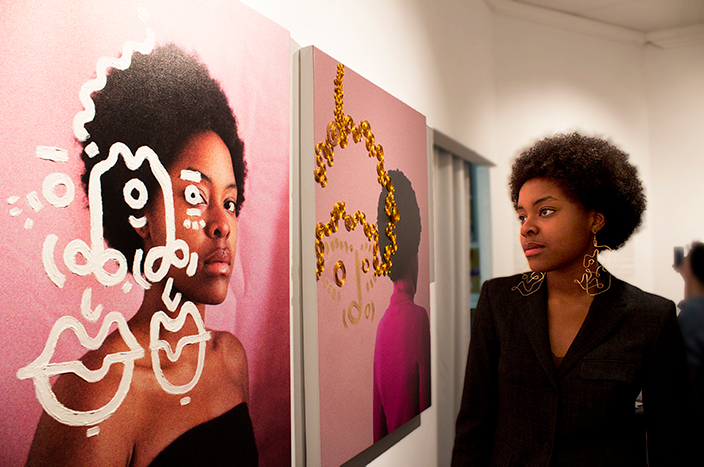Symbols of Resistance, on display at Galerie Mile-End Ame Art until the end of Black History Month, is an exhibition showcasing the work of local and international black artists. Annick Gold, organizer, along with a committee, selected the work of Kay Nau, Glowzi, Sika Valmé, Valérie Bah, Chelsy Monie, Carl-Philippe Simonise, Aïssatou Diallo, and Po B. K. Lomani after receiving as many as 30 submissions. While Symbols of Resistance is currently based out of Montreal, the artists and organizers of the event hope to eventually mobilize their message and take the show on tour.
Through a series of mixed media works, including photography, digital art, print, and painting, the artists expand on themes that encapsulate the past and present, individual and collective identities, and underlying elements of sexuality, gender, and resistance. The exhibition hopes to continue the dialogue about interracial relations and the role of black individuals within the Montreal community that often seems restricted to the thirty day period.
“Often these conversations are only had in black history month, and then it’s like they just don’t exist anymore,” Gold said. “We want to make sure that this conversation goes on further and that these black artists have opportunities on a long term.”
Sika Valmé, originally of Haitian descent, uses her work to explore the intersection of sound and visuals that is expressed in her art. In Symbols of Resistance, her work catches moments of tension in pen, marker, oil pastel, and crayon by juxtaposing thick and thin line work, organic and linear forms, elements more personal to the artist, and those that are recognizable to the audience. The fluidity of the form, and the somewhat doodle-like quality of the paintings instill a definitive musical quality to the work—Valmé captures a shower of notes, or the sensation of a pulsing beat through the psychologically abstract elements meant to express ‘introspective strength and human emotions.’
In addition to her art, Valmé also writes and produces her own music, and while her own sounds undoubtedly inspire much of the visual art she produces, other artists such as Bonobo, the Cranberries, and Thievery Corporation prompted the introspective quality of the pieces seen in the show.
Though portraiture is typically used to celebrate an individual’s identity, Chelsy Monie’s “Crowning” instead encourages the viewer to reflect on the significance of the head wrap in the black community and challenges the traditional roles of audience and subject. The piece uses the figures’ blacked out and ‘soulless’ eyes as a way for the viewer to embody her. The six-part series is composed of print-on-wood auto portraits, each capturing a black and white moment of Monie wearing a head wrap, and using topographical detailing and grid lines that have been inscribed onto the figures.
“Topographic maps are maps where lines and curves are used to represent the reliefs on land,” Monie said. “What this allows you to do is to view the head wrap as showing a location that is in space and time, and this is [only] emphasized by the lines of longitude and latitude. I’m really trying to have the viewer question how we can look at space.”
There is an eerie quality to Monie’s work, allowing the viewer to confront historical and contemporary conceptions of traditional garments, and the discomfort found in removing distinct facial features such as the eyes. As part of her self-created program, Ubuntu Talks, Monie will also be wearing a head wrap every day for the month of February, as a way of exploring the role of the head wrap in black culture and the way it will change her perceptions of her own identity.
Symbols of Resistance is an exhibition both about individual artists’ experiences within the black community, and a way for them to become a part of movements and conversations entrenched in global and Canadian history. Art is offered as a medium for transcending time; within each photograph or stroke of a digital pen, viewers are made to step outside of a hashtag or temporary profile picture into a position of greater compassion and racial solidarity.








